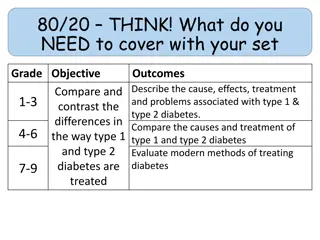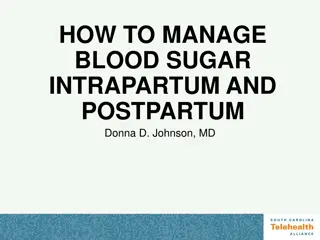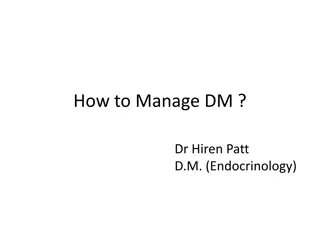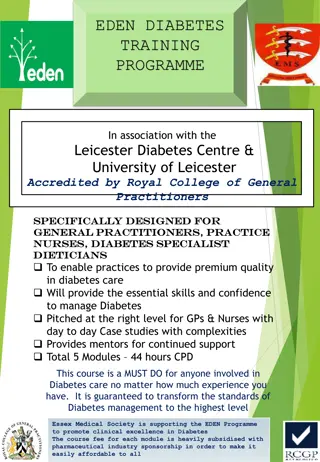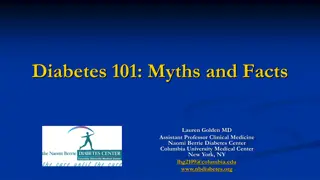Nutritional Recommendations for Type 2 Diabetes Management
Regularity and consistency in diet are crucial for individuals with type 2 diabetes to maintain stable blood sugar levels. The new nutritional pyramid recommended by the Ministry of Health of the Republic of Lithuania emphasizes the importance of balanced nutritional choices for managing diabetes. Nutritional goals for type 2 diabetes include achieving optimal weight, blood pressure, lipid levels, and glycemia to prevent complications. Teaching patients about nutrition involves considering their specific needs and abilities, with tailored recommendations based on their treatment methods.
Download Presentation

Please find below an Image/Link to download the presentation.
The content on the website is provided AS IS for your information and personal use only. It may not be sold, licensed, or shared on other websites without obtaining consent from the author.If you encounter any issues during the download, it is possible that the publisher has removed the file from their server.
You are allowed to download the files provided on this website for personal or commercial use, subject to the condition that they are used lawfully. All files are the property of their respective owners.
The content on the website is provided AS IS for your information and personal use only. It may not be sold, licensed, or shared on other websites without obtaining consent from the author.
E N D
Presentation Transcript
Connected 4 Health Basic nutrition fortype 2 diabetes Authors: Aelita Skarbaliene, Akvile Sendriute
Project Number: 2021-1-RO01-KA220-HED-38B739A3 The European Commission's support for the production of this presentation does not constitute an endorsement of the contents, which reflect the views only of the authors, and the Commission cannot be held responsible for any use which may be made of the information contained therein. 2
Regularity and consistency of diet is very important for patients with any type of DM: similar amount of carbohydrates at similar times. Such a diet helps maintain less variable glycemia (no swings inbloodsugar). In this lessonyou will learn about nutritional recommendations for type 2 diabetes treated with oral hypoglycemicagents, GLP-1 agonists, basal or mixed-acting insulin, and gestational DMtreated with diet. 3
The new nutritional pyramid recommended by The Ministry of Health of the Republic of Lithuania is also suitable for people with DM Nutritional products, vegetables,fruit. Protein products (meat, eggs, cheese, milk) make up only about 1/4 of the diet. Fats and sweets of animal origin should be consumedin moderation. basis: grain 4
Nutritional goals for type 2 diabetes: Optimalweight(toreduce insulinresistance) Optimal blood pressure and lipid content (to prevent vascularcomplications) Optimalglycemia(topreventDMcomplications) Patients of these groups are recommended to follow the principles of a healthy diet and change their eating habits according to their needs (due to overweight, increased bloodpressure,lipidlevels,etc.). 5
When teaching the patient about nutrition, it is necessary to consider the patient's individual needs and abilities. Patients on oral hypoglycemic agents, GLP-1 RAs, basal or mixed insulins, those with gestational DM, and the pill have difficulty counting carbohydrates and do not need it. Therefore, these patients are recommended to follow the principles of a healthy diet, changing their eating habits as needed; therefore,the "plate" or "palm" portionmethodsare explainedtothem. Thefollowingarespecificrecommendations. 6
For patients, the need for nutrients is calculated individually with their weight, age, physical activity, gender, and treatment taken into account. There are several ways to calculate the amount of energy required daily. The first method is based on the statistically reliable Harris Benedict formula (available online). The second way to calculate the amount of calories you need to consume is simpler. The ideal weight is calculated with the body mass index (BMI) formula applied; i.e. with a BMI of 22. So if BMI = Weight (kg) / Height (m2), then ideal weight = BMI x Height (m2). Then the obtained body mass is multiplied by 25-30, since it is believed that one kilogram of body mass requires 25-30 kcal, depending on the person's physical activity. So, according to the same example, a physically active person should consume: 22 x 2.89 x 30 = 1907 kcal per day. 7
The distribution of food energy substances can vary dependingonthepatient'shabitsandneeds. Weight reduction (7% of body weight) is recommended foroverweight orobese patients.Ifthe patientisobese or overweight, 500 kcal should be subtracted from the recommended caloric intake. Then it is likely that you will lose0.5kg ofweightpermonth. 8
Constancy and regularity of nutrition is important. 3 main meals (breakfast, lunch, dinner) with a similar amount of carbohydrateseachdayarerecommended. 2-3 light (low-calorie, low-carb) snacks are allowed betweenmainmeals. Complex carbohydrates should be eaten with every main mealtoavoidhypoglycemia. 9
Simple carbohydrates should make up no more than 10 percent of all recommended carbohydrates (sugar and sweets are not prohibited). The amount of vegetables (non-starchy) is not limited (about500 g per day). Fluids are recommended at 1-1.5 litres per day, preferably water. It is recommended to eat sea fish 2-3 times a week (dueto omega 3acids). Reduce salt intake - less than 5g per day (for BP). It is better to use fats of vegetable origin: rapeseed, olive oil. Animal fats (butter, mayonnaise, lard) should be used sparingly to prevent the cardiovascular diseases. 10
Sugar substitutes do not increase glycemia, but they should be used in moderation. More natural sugar substitutes (such as stevia) can be used as sweeteners. Sweets should not be eaten every day. Products with a low glycaemic index are more recommended because they raise glycemia more slowly and have a positive effect on the triglyceride level (reduce it). Eat whole grain foods with more fibre - 25-50 g per day. Alcohol - for women no more than 1, for men no more than 2 units of alcohol per day. One unit of alcohol is: 50 ml of vodka or 120 ml of wine or 160 ml of beer. 11
Palm portion method To determine the portion size, the patient can use his palm, which is a very convenient way to estimate the amount of the selected food. 12
Equivalents of the palm portion method Handful - one portion of vegetables (1 glass). Clenched fist one serving of carbohydrates, such as porridge (1 cup), or medium sized fruit. Palm without fingers one serving of protein, such as meat or fish (meat or fish the thickness of the piece should be the size of the little finger of the hand). 2 fingers - one portion of cheese (30g). Thumbs one serving of low-fat mayonnaise or salad dressing (1 tablespoon). Tip of the thumb one portion of butter, margarine, oil (1 teaspoon). 13
The plate portion method The plate portion method can also help you eat healthy. When applying it, you need to choose a medium-sized plate: half of the plate should be filled with vegetables (any, raw or cooked); vegetables should be placed on the plate first; a quarter of the plate should be filled with protein products (meat, fish); a quarter of the plate should consist of starchy products (potatoes, cereals, pasta, bread); a portion of milk and fruit can be added to make the diet complete. 14
References Guo Y, Huang Z, Sang D, Gao Q and Li Q (2020) The Role of Nutrition in the Prevention and Intervention of Type 2 Diabetes. Front. Bioeng. Biotechnol. 8:575442. doi: 10.3389/fbioe.2020.575442 KnowlerWC, Barrett-Connor E, Fowler SE, Hamman RF, Lachin JM, Walker EA, Nathan DM. Reduction in the incidence of type 2 diabetes with lifestyle intervention or metformin. The New England journal of medicine. 2002 Feb;346(6):393-403. Kurza D, KobosE. Diabetes distress in adult patients with type 1 and type 2 diabetes. Med Sci Pulse 2022; 16(4): 56 65. DOI: 10.5604/01.3001.0016.1166 Rajput SA, Ashraff S, Siddiqui M. Diet and Management of Type II Diabetes Mellitus in the United Kingdom: A Narrative Review. Diabetology. 2022; 3(1):72-78. https://doi.org/10.3390/diabetology3010006 Sami W, Ansari T, Butt NS, Hamid MRA. Effect of diet on type 2 diabetes mellitus: A review. Int J Health Sci (Qassim). 2017;11(2):65-71. 15




